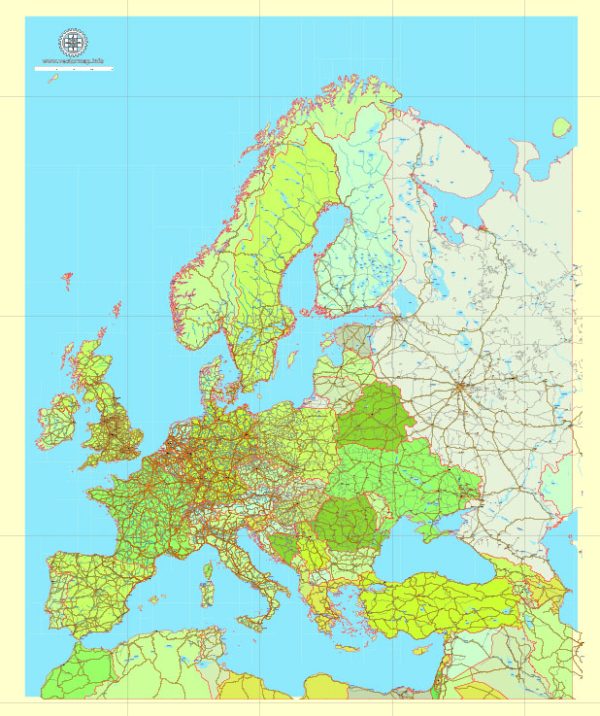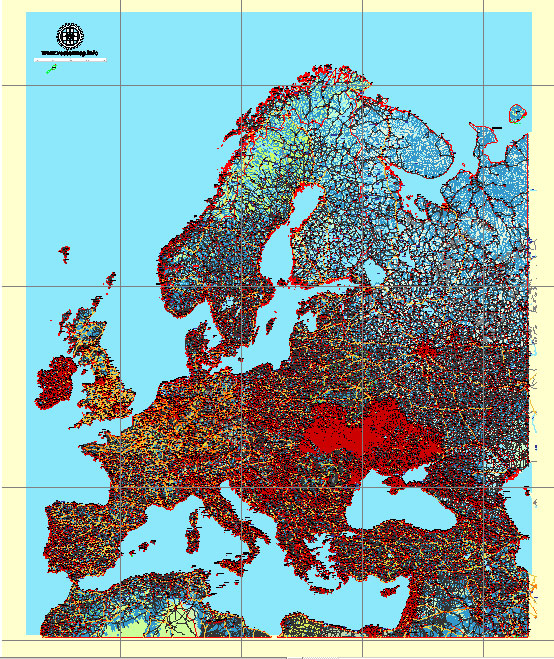The political and economic history of Europe is vast and complex, spanning thousands of years and encompassing a multitude of cultures, nations, and events. A comprehensive overview can only provide a broad outline of key developments.
Vectormap.Net provide you with the most accurate and up-to-date vector maps in Adobe Illustrator, PDF and other formats, designed for editing and printing. Please read the vector map descriptions carefully.
Here’s a brief overview:
Ancient and Medieval Periods:
Political:
- Ancient Greece and Rome (c. 8th century BCE – 5th century CE): Birthplaces of democracy and republicanism, respectively. Greece’s city-states and Rome’s empire influenced political thought.
- Feudalism (9th – 15th centuries): A hierarchical system where land was exchanged for military service. Monarchies and local lords held power.
Economic:
- Agriculture-based Economy: Primarily agrarian societies with trade routes connecting various regions.
- Medieval Trade Routes: Emergence of trade routes like the Silk Road, fostering economic interactions between Europe, Asia, and Africa.
Renaissance and Early Modern Periods (14th – 18th centuries):
Political:
- Renaissance (14th – 17th centuries): Intellectual and cultural revival, contributing to the emergence of modern political thought.
- Reformation (16th century): Religious movements challenging the authority of the Catholic Church, leading to the rise of Protestantism.
Economic:
- Age of Exploration (15th – 17th centuries): European nations expanded trade and established colonies, marking the beginning of global capitalism.
- Mercantilism: Economic theory emphasizing the importance of accumulating wealth through trade and colonization.
Enlightenment and the Modern Era (18th – 20th centuries):
Political:
- Enlightenment (17th – 18th centuries): Philosophical movement promoting reason, science, and individual rights.
- French Revolution (1789): Catalyst for political changes across Europe, inspiring nationalism and the spread of liberal ideals.
Economic:
- Industrial Revolution (18th – 19th centuries): Transition from agrarian to industrial economies, leading to urbanization and significant technological advancements.
- Capitalism: Economic system emphasizing private ownership and market-driven economies.
19th and 20th Centuries:
Political:
- Nationalism: Rise of nation-states and nationalist movements.
- World Wars (1914-1918, 1939-1945): Shaped the geopolitical landscape of Europe, leading to the Cold War.
Economic:
- Post-World War II Reconstruction: Marshall Plan aimed at rebuilding war-torn Europe.
- European Union (1951): Economic and political integration, fostering cooperation among member states.
Contemporary Period (Late 20th century – Present):
Political:
- End of the Cold War (1989): Collapse of the Soviet Union, leading to significant political changes in Eastern Europe.
- Expansion of the European Union: Enlargement to include former Eastern Bloc countries.
Economic:
- Eurozone (1999): Adoption of a common currency by several EU member states.
- Globalization: Increased interconnectivity of European economies with the rest of the world.
This overview is necessarily concise and generalized. Each country in Europe has its own unique political and economic history, contributing to the rich tapestry of the continent’s past.



 Author: Kirill Shrayber, Ph.D.
Author: Kirill Shrayber, Ph.D.